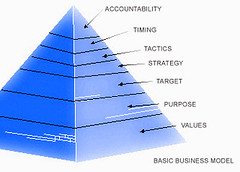Lawrence Ragan Communications, Inc. (Ragan) is considered by many to be the leading publisher of corporate communications, public relations, and leadership development newsletters. Today, it began promoting a new webinar, teasing with journalist Tom Foremski's famous 2006 blog post: "The press release is dead."
Is the press release dead? Not dead, perhaps, but wounded. Certainly social media has caused public relations professionals to reevaluate many long-standard practices, including the press release (though I prefer the term "news release").
Going further, public relations professionals have been busy developing a new standard, which Ragan and some others call the "social media release." According to their webinar description, this standard takes into consideration blogs, RSS technology, and the emerging breed of citizen journalists.
Personally, it seems to me that what we're seeing in communication is a random mutation in one species, but that is not to say that other species are extinct. Right now, news releases, "social media" releases, and corporate blog entries can all be employed strategically for different purposes. A quick example: a company can send out a new release to traditional outlets, include a variation to select bloggers, and then augment the information with personal comment by executives or other team members on their respective or shared blogs. (Or sometimes, maybe some "news" or semi-interesting tidbit is not fit for traditional media, but is certainly suitable for a blog. The other way around works too.)
Looking back over some recent commentary, maybe that was part of the answer in the recruiting world: perhaps Jobster's initial communication to address media speculation was more fitting for a news release and TalentZoo's "jab Jobster" news release more fitting for a blog entry.
Or, if you prefer, using Cisco and Apple as an example, as they seem to be right in step with this thinking: Apple sends out a release on the iPhone; Cisco sends out a release about its lawsuit. Then, Cisco augments its argument on its blog and Apple addresses the lawsuit with analysts, which is then filtered to social media outlets.
Regardless, there seems to be no argument that corporate communication and public relations is changing. The only question now is what to do about it. It will be interesting to see what comes out of the Ragan webinar.
In the interim, I'll be telling some professionals tonight that it is not enough to be a "public relations" practitioner. Nowadays, you have to think like a journalist, act like a business strategist, and write with the passion of a creative writer. And, given social media today, appeal to the casual reader who just happens to visit from time to time.
Is the press release dead? Not dead, perhaps, but wounded. Certainly social media has caused public relations professionals to reevaluate many long-standard practices, including the press release (though I prefer the term "news release").
Going further, public relations professionals have been busy developing a new standard, which Ragan and some others call the "social media release." According to their webinar description, this standard takes into consideration blogs, RSS technology, and the emerging breed of citizen journalists.
Personally, it seems to me that what we're seeing in communication is a random mutation in one species, but that is not to say that other species are extinct. Right now, news releases, "social media" releases, and corporate blog entries can all be employed strategically for different purposes. A quick example: a company can send out a new release to traditional outlets, include a variation to select bloggers, and then augment the information with personal comment by executives or other team members on their respective or shared blogs. (Or sometimes, maybe some "news" or semi-interesting tidbit is not fit for traditional media, but is certainly suitable for a blog. The other way around works too.)
Looking back over some recent commentary, maybe that was part of the answer in the recruiting world: perhaps Jobster's initial communication to address media speculation was more fitting for a news release and TalentZoo's "jab Jobster" news release more fitting for a blog entry.
Or, if you prefer, using Cisco and Apple as an example, as they seem to be right in step with this thinking: Apple sends out a release on the iPhone; Cisco sends out a release about its lawsuit. Then, Cisco augments its argument on its blog and Apple addresses the lawsuit with analysts, which is then filtered to social media outlets.
Regardless, there seems to be no argument that corporate communication and public relations is changing. The only question now is what to do about it. It will be interesting to see what comes out of the Ragan webinar.
In the interim, I'll be telling some professionals tonight that it is not enough to be a "public relations" practitioner. Nowadays, you have to think like a journalist, act like a business strategist, and write with the passion of a creative writer. And, given social media today, appeal to the casual reader who just happens to visit from time to time.




















